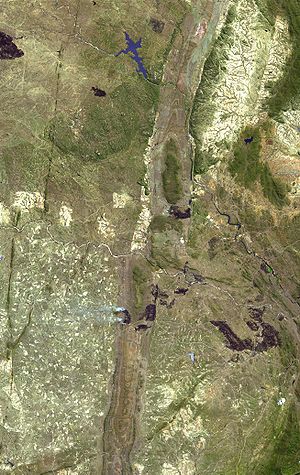Great dyke
The Great Dyke is a magmatite body characterized by a pronounced syncline structure , which runs through Zimbabwe in the form of a 550 km long, narrow line roughly in a north-south direction. Its width varies between about 4 and 11 kilometers. Like the greenstone belt , it is rich in economically important minerals and ores and is mainly characterized by ultra-mafitites , accompanied by dolerites , gabbros and norites .
Chromium , nickel , gold , silver , platinum , tin , mica and asbestos are mined here. The layers of chrome ore ( chromite ), mostly enclosed in dunite structures , are among the most important deposits for the metallurgical industry worldwide. The platinum deposits had sparked intense interest in the South African Union around 1927 . Due to the conditions of the deposits and the complicated extraction methods involved, platinum mining activities subsided again.
Most of the mining cities of Zimbabwe like Shamva , Bindura , Kadoma with Muzvezve , Kwekwe , Redcliffe , Gweru , Shurugwi , Somabhula , Mashava Mine are located on the Great Dyke. This is a narrow band of hills and rock ridges in the south, which become higher towards the north, where they reach a height of 460 m with the Umvukwe plateau.
A dyke is formed by the penetration ( intrusion ) of liquid rock ( magma ) into rocks that have already formed . The Great Dyke formed about 2.6 billion years ago. Its age could not be determined in connection with the sediment systems widespread in Zimbabwe because it is surrounded by a basement complex as an isolated body . For the most part, it has not been deformed or changed since its creation.
It extends to the Bushveld Complex in the Transvaal in the Republic of South Africa , which is another 500 km south of its southern end. The richest ore deposits on earth are found there.
History of its exploration
The Great Dyke was first explored by Carl Mauch in 1867 . Nevertheless, its rich ore deposits were not recognized until 1918 and then systematically developed.
Literature and web links
- John M. Guilbert, Charles F. Park, Jr .: The Geology of Ore Deposits. Freeman 1986, ISBN 0-7167-1456-6
- R [ené]. A [rthur]. Pelletier: Mineral Resources of South-Central Africa . Oxford University Press, Cape Town / London / New York / Toronto 1964, pp. 140, 160-161.
- Mining in Zimbabwe (English)
- Description of the country with geology (English)
